
Mastaba of Mereruka
![]()
| Mereruka was the vizier to Teti, who was pharaoh during the 6th Dynasty. He was also married to Teti's daughter, Hert-watet-khet. She is buried in the mastaba as well as their son, Meriteti. The Mastaba of Mereruka is the largest in Saqqara. |
![]()
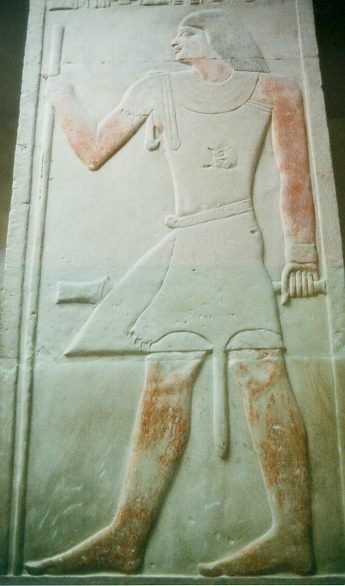 Mereruka appears
on each of the columns in the Sacrificial Chamber in his tomb in Saqqara. The
various costumes correspond to his official functions. The panther skin is part of
the ceremonial dress of the high priest. The panther symbolizes the feral and
predatory aspects of nature. The priest in his ceremonial panther skin is victor
over that aspect of his nature.
Mereruka appears
on each of the columns in the Sacrificial Chamber in his tomb in Saqqara. The
various costumes correspond to his official functions. The panther skin is part of
the ceremonial dress of the high priest. The panther symbolizes the feral and
predatory aspects of nature. The priest in his ceremonial panther skin is victor
over that aspect of his nature.
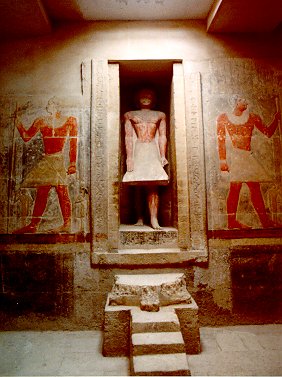 ka statue of Mereruka
in front of the offering table in his mastaba tomb at Saqqara.
ka statue of Mereruka
in front of the offering table in his mastaba tomb at Saqqara.
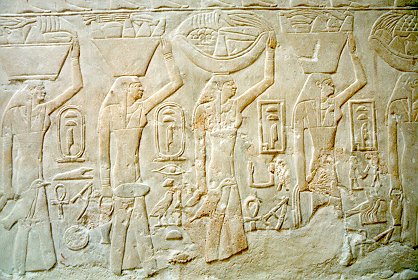 An illustrated
version of the title deeds to one's estates was often represented in a tomb as a
procession of women bringing offerings or leading animals. The nouns 'estate' and
'village' are of feminine gender, hence the sex of these offering bearers.
An illustrated
version of the title deeds to one's estates was often represented in a tomb as a
procession of women bringing offerings or leading animals. The nouns 'estate' and
'village' are of feminine gender, hence the sex of these offering bearers.
Estate managers
(heka hut) are brought before a council of scribes in order to render accounts of their
farms.
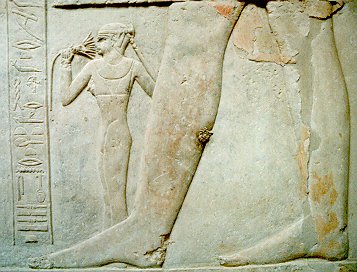 Mereruka's wife,
Hert-watet-khet
(aka Seshseshet), sniffs
a lotus flower. Lotus symbolism pervades Egyptian symbology. It is the very behavior of the flower that gives rise to this
symbolism. Sinking to the bottom of the water at night, it awakens and
blossoms at the first rays of the morning sun.
Mereruka's wife,
Hert-watet-khet
(aka Seshseshet), sniffs
a lotus flower. Lotus symbolism pervades Egyptian symbology. It is the very behavior of the flower that gives rise to this
symbolism. Sinking to the bottom of the water at night, it awakens and
blossoms at the first rays of the morning sun.
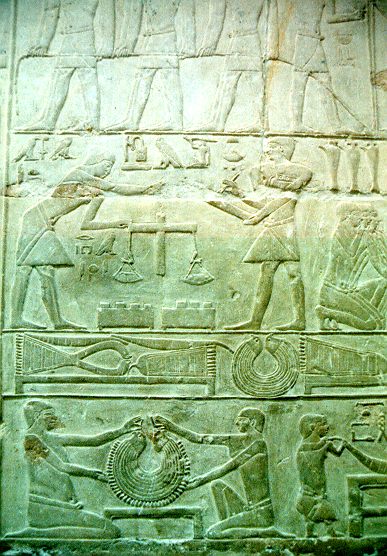 Craftsmen shown
in Mereruka's tomb include metalworkers and dwarves (shown lower right) employed in
the manufacturing of jewelry. Dwarves are common only in the Old Kingdom tombs. Above the
jewelry making scene, a supervisor weighs out the gold.
Craftsmen shown
in Mereruka's tomb include metalworkers and dwarves (shown lower right) employed in
the manufacturing of jewelry. Dwarves are common only in the Old Kingdom tombs. Above the
jewelry making scene, a supervisor weighs out the gold.
© All pictures are Copyright 1998 - 2001 Grisel Gonzalez